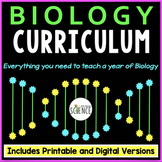DNA, RNA, Protein Synthesis Bundle
- Zip
- Google Apps™

What educators are saying
Products in this Bundle (22)
showing 1-5 of 22 products
Bonus
Also included in
- This NO PREP, PRINTABLE, EDITABLE, AND DIGITAL Biology Curriculum contains everything you need for an entire year of Biology! For less than $3 a day, you can save your time, energy, and sanity. Each of the 20 Complete Units includes a teaching PowerPoint presentation, notes, labs, homework assignmenPrice $525.00Original Price $988.18Save $463.18
Description
This complete teaching unit on DNA, RNA, and Protein Synthesis includes everything you need to teach this unit to your life science or biology students. Resources include a 120-slide PowerPoint presentation packed with colorful and interesting photographs and images, teacher notes, printable and digital student notes, labs, study guides, homework assignments, Jeopardy-style review games, crossword puzzles, quizzes, and final unit tests. Includes everything you need right at your fingertips for a complete unit on DNA and RNA.
From the engaging PowerPoint to the final unit test, this bundle contains loads of NO PREP materials that are ready to be used with your students. Many of the resources in this bundle are available in paperless digital formats for use in Google Drive, Google Classroom, Microsoft OneDrive, or similar.
What is included in this bundle? ( Items marked with ** have both printable and digital versions.)
- DNA, RNA, and Protein Synthesis PowerPoint and Notes Set **
- Lab: Translation and Protein Synthesis Determining Traits of Mystery Organism **
- Lab: Simple DNA Extraction
- Homework #1: The Basics of DNA **
- Homework #2: DNA Replication **
- Homework #3: RNA and Transcription **
- Homework #4: Protein Synthesis and Translation **
- Quiz #1: DNA and Replication **
- Quiz #2: RNA and Transcription **
- Quiz #3: Translation and Protein Synthesis **
- DNA, RNA and Protein Synthesis Study Guide **
- DNA Powerpoint Jeopardy Review Game
- RNA and Transcription Powerpoint Jeopardy Review Game
- Translation and Protein Synthesis Powerpoint Jeopardy Review Game
- Crossword Puzzle: DNA and Replication
- Crossword Puzzle: RNA and Transcription
- Crossword Puzzle: Translation and Protein Synthesis
- Crossword Puzzle: DNA, RNA and Protein Synthesis
- Test: DNA and Replication **
- Test: RNA, Transcription and Translation **
- Test: DNA, RNA, and Protein Synthesis **
- Chart of Amino Acids and Their Codons
- DNA Informational Text and Graphic Organizers **
I have also included a Teacher Guide containing tips for implementation, suggestions for sequencing, and alignment to NGSS standards.
When appropriate, I have included each product as an editable Word document, and I have also included each product in pdf form.
All answers are included.
Topics covered by this unit include:
- History of DNA Studies: Early concepts about genes, roles played by genes, Watson and Crick, Chargaff, Rosalind Franklin, Maurice Wilkins.
- DNA nucleotides and their composition, purines, pyrimidines, how nucleotides are joined to one another, nitrogen bases.
- Chargaff’s Rules and the X-Ray evidence by Rosalind Franklin
- The Watson and Crick model of DNA, the double helix, the base pairing rules, DNA as a carrier of information.
- Mechanisms by which a large amount of DNA can fit inside a small space of the nucleus, histones, nucleosomes.
- Replication of DNA: Drawings, steps in replication, DNA polymerase, hydrogen bonds, origins or replication, replication forks, complementary strands, helicase.
- Proofreading and repairing DNA: the role of polymerases, nucleases, and ligases.
- The Genetic Code: codons, amino acids.
- RNA: Differences between DNA and RNA, the functions of RNA, the three types of RNA (mRNA, tRNA, rRNA).
- Transcription: Purpose of transcription, steps to transcription, promoter, terminator, RNA polymerase.
- RNA processing and editing, introns, exons.
- Understanding the genetic code, how codons translate into amino acids, start codons, stop codons, reading a table of codons.
- Translation: protein synthesis, ribosomes, steps in translation, the role of mRNA and the role of tRNA, structure of tRNA and its ability to transport amino acids, reading and deciphering the code.
- Practice Problem: Given a DNA sequence, students will figure out the corresponding mRNA codon sequence, the tRNA anticodon sequence, and the amino acid sequence.
- Ribosome structure: large subunit, small subunit, RNA binding sites, the entry and exit of tRNA to build a polypeptide, start codons, stop codons.
- Mutations: definition of mutation, gene mutations, chromosome mutations, point mutations, base substitutions, base insertions or deletions, silent mutations, frameshift mutations, the importance of mutations in natural selection.
For updates about sales and new products, please follow my store:
My TpT Store: Amy Brown Science
You can find me at these locations as well:
My Blog: Amy Brown Science.com
Instagram: @AmyBrownScience






